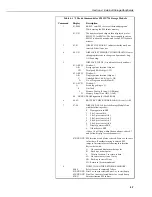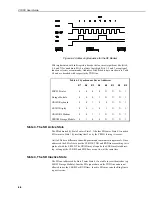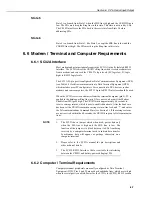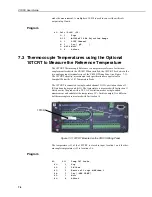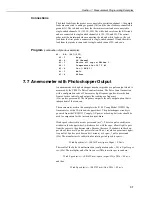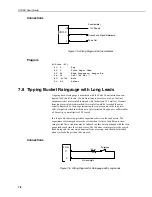
CR10X User Guide
6-4
After the CR10X has determined which peripheral raised the Ring line, the hierar-
chy is as follows:
A modem which raises the Ring line will interrupt and gain control of the CR10X.
The one exception is that a modem cannot interrupt an active RF-SDC. A Ring
from a modem aborts data transfer to pin-enabled and addressed peripherals.
The CR10KD raises the Ring line whenever a key is pressed. The CR10KD will
not be serviced when the modem or RF-SDC is being serviced. The Ring from the
CR10KD and RF-SDC is blocked when the SDE line is high, preventing it from
interrupting data transfer to a pin-enabled print device.
6.3 Interrupts During Data Transfer
Instruction 96 is used for on-line data transfer to peripherals (see Section 4). Each
peripheral connected to the CR10X requires an Instruction 96 with the appropriate
parameter. If the CR10X is already communicating on the 9-pin connector when
Instruction 96 is executed, the instruction puts the output request in a queue and
program execution continues. As the 9-pin connector becomes available, each
device in the queue is serviced in turn until the queue is empty.
Instruction 96 is aborted if a modem raises the Ring line. Data transfer to an
addressed peripheral is aborted if the Ring line is raised by a CR10KD or an RF
Modem configured as a synchronous device. Transfer of data is not resumed until
the next time Instruction 96 is executed and the datalogger has exited tele-
communications.
The *8 Mode is used to manually initiate data transfer from Final Storage to a
peripheral. An abort flag is set if any key on the CR10KD or terminal is pressed
during the transfer. Data transfer is stopped and the memory location displayed
when the flag is set. During a *8 Mode data transfer the abort flag is checked as
follows:
1.
Comma separated (comma delineated) ASCII — after every 32 characters.
2.
Printable ASCII — after every line.
3.
Binary — after every 256 Final Storage locations.
6.4 Modem / Terminal Peripherals
The CR10X considers any device with an asynchronous serial communications
port which raises the Ring line (and holds it high until the ME line is raised) to be
a modem peripheral. Modem/terminal peripherals include telephone modems and
computers or terminals using the SC32A RS232 Interface or the SC932 RS-232
DCE Interface.
When a modem raises the Ring line, the CR10X responds by raising the ME line.
The CR10X must then receive carriage returns until it can establish the baud rate.
When the baud rate has been set, the CR10X sends a carriage return, line feed, and
‘*’.
The ME line is held high until the CR10X receives an ‘E’ to exit telecommuni- ca-
tions. The ME is also lowered if a character is not received after 40 seconds in the
Telecommunications Command State (two minutes in the Remote Keyboard
State).
Some modems are quite noisy when not on line, and it is possible for valid char-
acters to appear in the noise pattern. For this reason, the CR10X counts all the
invalid characters it receives from the time it answers a Ring, and terminates


